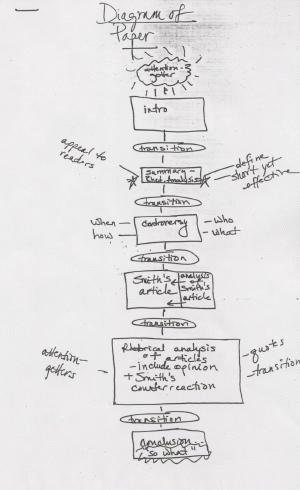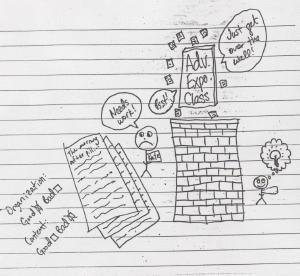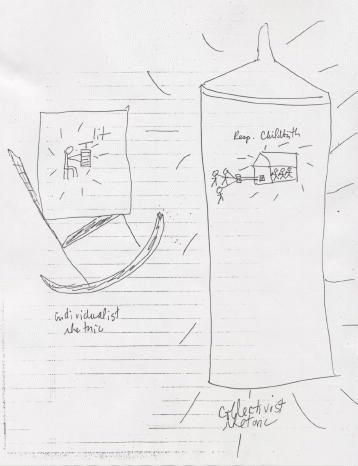Sketching-to-Learn (as an Invention and Revision Strategy)
In the same way we use freewriting as an invention strategy, we can experiment
with sketches, graphs, and drawings to help spark ideas and connections between
them. One need not be particularly talented to represent visually an idea one
is beginning to explore. In fact, stick-people sketches, simple geometric designs,
or Venn diagrams can be drawn very quickly by the most artistically untalented
among us and then explained and expanded upon either orally or in writing. These
quick sketches or diagrams are invention tools, much like freewriting. They
can help us see connections, think of metaphors, or help us solve problems in
our drafts or early conceptions of a writing project.
Sketching is a great way to respond to complex readings. Even primitive drawings
or graphs can help people conceptualize complex ideas and contrasting views
before they write about them. Sketching, like freewriting, can also help people
not only generate ideas, but also help them begin to conceptualize how they
might organize, or reorganize, their early or developing drafts.
Here are a few sketches students did in five to ten minutes of class time.
They were working on a 12-page rhetorical analysis, a project that required
them to read a number of suasive texts concerning a controversy of their choosing,
and then to analyze the rhetorical strategies used in those texts. For example,
they were to locate explicitly rhetorical pieces, such as commentaries, editorials,
syndicated columns, etc., representing various positions in a controversy of
their choosing (racial profiling, efficacy of the anthrax vaccine, renovation
of Soldier Field in Chicago, wolves in Yellowstone Park, etc.) And then they
were to examine the rhetorical strategies used by rhetors on different sides
of the controversy. Many students found this project a nightmare. They had to
learn not only to conceptualize the task they were undertaking - how to analyze
the not always obvious rhetorical strategies in the texts they were reading - and
then to organize the rhetorical tour they were taking their readers through.
Since so many students were confused and frustrated by this project, they were
given about ten minutes of class time one day to sketch out the present (or
proposed) organization of their papers. Here are the student sketches and their
explanations.
|

Sketch A - Click on image for larger view.
|
|
Sketch A - This
is "Jessica's" sketch of her draft at about the midpoint of
this rhetorical analysis project. It says, "Diagram of Paper,"
and it is a linked series of flattened circles and squares with labels
such as "summary of rhetorical analysis," and "Smith's
article," and "analysis of Smith's article." Here is what
she said about her sketch:
This sketch
represents my ideal paper, or what I hope my paper looks like when completed.
The "boxes" or rectangles represent the major topics of the
paper and how much emphasis will be placed on them (as shown by size).
Ovals between all paragraph, and the attention-getter "sparks"
around it because it is perhaps the most important part of my paper.
If I want the readers to be interested and read my paper, the first
sentence must stand out. Tied in with the conclusion, the "so what"
question also has "sparks" around it, emphasizing the fact
that this question must be addressed and answered if my paper is to
have a purpose.
|
|
|

Sketch B - Click on image for larger view.
|
Sketch B - This
is "Karen's" sketch of her draft at about midpoint in her
rhetorical analysis project. There is a stick figure with an unhappy
face trying to get her paper over a brick wall of this class project.
Here is what she said about her sketch:
This sketch
shows two sides of me. The me on the left is me now. The me on the
right is hopefully the me very soon. Separating the two me's is a
brick wall which I must overcome. Me-now is not happy with her paper,
while future me is inspired and full of ideas. I must defeat the brick
wall before I can hand in my paper. Hovering over the brick wall is
this class, surrounded by everyone else's papers. This class, their
ideas, and their papers are trying to help me look over the wall and
see my inspiration.
|
Then we talked about these student sketches in class, either via the blackboard,
white board, overhead projector, or the student simply showing around his or
her sketch. Hearing the various approaches and organizational patterns seemed
to help everyone generate possible major revisions in their own work. Hearing
these overviews also provided opportunities to intervene in the revising process:
to discourage long, boring summaries of their controversy, for example, and
to encourage instead the more sophisticated analysis of the rhetoric used in
written arguments concerning the controversy.
Sketched Responses to Readings
A few weeks ago, in a graduate class in Research Methods in Composition Studies,
we were discussing Gregory Clark's and Stephen Doheny-Farina's article, "Public
Discourse and Personal Expression: A Case Study in Theory Building" (Written
Communication 7.4 October 1990, 456-481). It is a complex analysis of a student,
"Anna," who must learn both the discourse conventions in, and quite
different assumptions regarding, writing required in a college literature seminar
and in a local community organization, Responsible Childbirth. As Clark and
Doheny-Farina explain, writing in the literature seminar seemed to value personal
expression and original ideas, while writing at the social agency seemed to
value a "collectivist" approach that furthered the aims of the organization.
At the end of their analysis, Clark and Doheny-Farina invite alternate interpretations
of their analysis.
To start the class discussion of this article, class members were asked to
sketch "Anna's" predicament as described and situated by Clark and
Doheny-Farina. After they completed that visual representation of the authors'
argument, they were then asked to incorporate the first sketch into another
one: Clark's and Doheny-Farina's interpretation of this case study, then contextualized
in the ways those authors invite us to. In other words, how might their interpretation
be situated in a set of assumptions in a way similar to what they describe about
Anna's two writing situations? Here was the instructor's sketch:
|

Dunn's sketch - Click on image for larger view.
|
|
Dunn's Sketch - On the
left is a stick figure (Anna) writing her literature paper. The focus
(light coming off in spokes) is on Anna as an individual and on her text.
On the right, at Responsible Childbirth, is Anna and her colleagues (in
the building, all with pens, all working on the text, which will be read
by different readers outside the agency. The focus (light coming off in
spokes) is not on the text or the writers, but on the agency itself, the
building in the sketch.
Here is the instructor's (Dunn's)
description of her sketch:
After I drew Anna and her
paper on the left and the agency writers and their building on the right,
I contextualized Clark's and Doheny-Farina's analysis. I drew a box
around the "Anna and her text" sketch (with the writers' title
"individualist rhetoric) and placed it in a rocking chair, because
in my view, Clark and Doheny-Farina interpret this view of writer and
text as old-fashioned and outmoded. Around my sketch of Anna at work
(with the writers' title "collectivist rhetoric") I drew a
baby bottle, because in my view, Clark and Doheny-Farina interpret this
view of writer as being the more desirable, current one. I do not claim
to have the last word on how to interpret this article.
|
The instructor's sketch, and the graduate students' sketches of this article - which
were all completely different - was a great way to begin discussion of this article
and of different assumptions about writer, text, and rhetoric. It also led to
a larger discussion of composition research, theory, and practice, a major topic
of this course.


